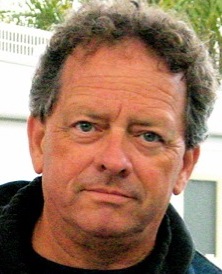The Windhook Interview—YaYa Chou
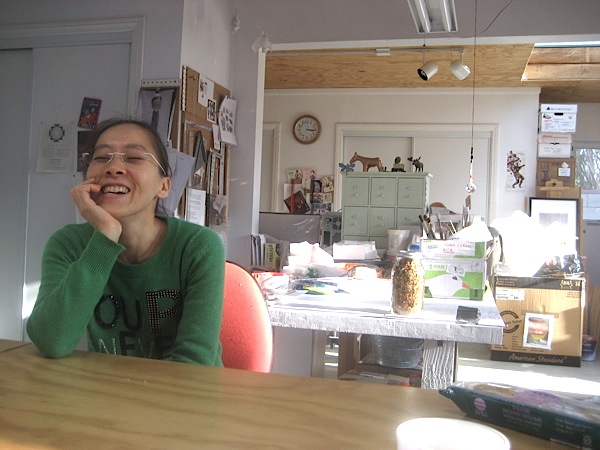 YaYa Chou is a sculptor, film maker and food activist in Los Angeles. We first met her when she entered California Slam, a statewide juried sculpture show in San Luis Obispo in August 2011. She placed second in that show. Michael was on the steering committee for California Slam, and when we met her there, we knew we wanted to interview her. We met with her for this interview over the holidays, a couple of days before New Year's Day. The interview was a lot of fun as you will see. You will probably want to spend a little time on her web site and her blog for a better picture of the remarkable career this young artist has already had.
YaYa Chou is a sculptor, film maker and food activist in Los Angeles. We first met her when she entered California Slam, a statewide juried sculpture show in San Luis Obispo in August 2011. She placed second in that show. Michael was on the steering committee for California Slam, and when we met her there, we knew we wanted to interview her. We met with her for this interview over the holidays, a couple of days before New Year's Day. The interview was a lot of fun as you will see. You will probably want to spend a little time on her web site and her blog for a better picture of the remarkable career this young artist has already had.
And as you read, be thinking about Peggy's top five list from last week. We think you'll see some pretty clear evidence here to support the thesis.
Michael: You studied at California Institute of the Arts, but before that you came from Taipei?
YaYa: Yes.
Michael: That's where you were born, and you went to school there. Tell us a little bit about your origins.
YaYa: Well, I was a normal Asian kid. I always knew I wanted to be an artist.
Michael: That was question number two.
YaYa: But I negotiated my way into art school because my family thought you should always go to the regular high school, and the regular university, and then you get to pick what you want after that. So I kind of veered a little bit. I went to the communication department and made film and learned broadcasting.
Michael: So communications was your angle to get to film.
YaYa: Yeah, it got me a little closer to what I wanted.
Peggy: Were there art high schools?
YaYa: Yes. For people who want to go to art school at the university level, they usually start when they're 13 in private after-school programs, then they will go to art high schools. But a lot of those are skills building educations, not concept. So they sketch all their life or sculpt and that's how they get in. But academic-wise, they aren't trained that much.
So in the last year at my college somehow I found a design studio and asked them to teach me 3-D computer animation, so I learned that on their computers so I could prepare for a portfolio because I needed something to apply for a masters program here.
Peggy: When you were in college you knew you wanted to come here for an MFA?
YaYa: Yeah, I just knew I wanted to come here and learn something in art. I didn't know if I would have to do another BFA because I didn't have any background but I thought I would give it a try. And Cal Arts has an experimental animation program that doesn't really require you to have formal training. You have to send a demo reel but you don't have to have a lot of sketches or life drawing and stuff like that. So I was really lucky. [Laughter]
Peggy: Had you been to Cal Arts before you applied?
YaYa: No, my sister was in Manhattan for 10 years, so I was thinking about NYU, but when I applied, they were postponing that program, because they were still trying something new. Savannah Art College in Georgia, wanted me to start with a BFA, but Cal Arts was really my first choice and they took me.
Michael: Did you get to go to one of those schools at 13 for artists, or...
YaYa: No, every three years we had to pass a national exam to go to regular high school and college. Every year I asked my mom if I can go to art school and she said, "Well, we'll see. If you don't make it to the top four then we'll think about it." But I always scored too high.
Peggy: What did your father do?
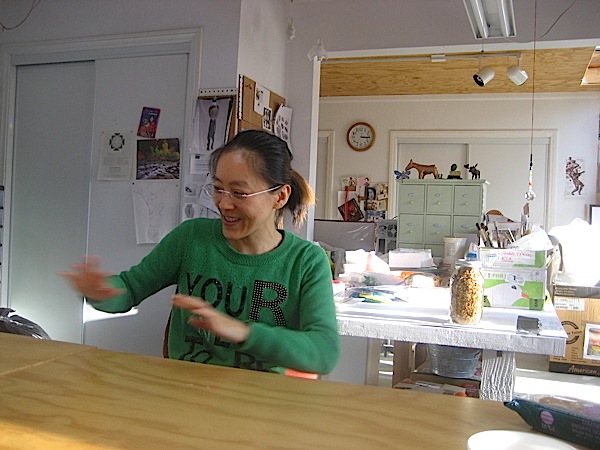
YaYa: My father is a retired general. And my mom was a soldier too. But I think he is very artistic. My grandfather was a writer. And my sister is a theater director and playwright.
Michael: So it's really a creative family.
YaYa: Yeah, it's just that at that time, with the war, there was no way for him to do what he wants so he joined the army to survive.
Peggy: He went very far!
YaYa: He came from China to go to the war. I'm actually glad they didn't let me go to art school now, actually. After many, many years I was holding that grudge, but now I look back and realize I can always learn how to sculpt or paint but I can never get that critical thinking that I got trained in college.
Michael: We were looking over your resume and noticed that you are only about a decade out of art school, and you've got quite a resume. You have some pretty big places that you have shown. You've been at The Museum of Modern Art, and...
YaYa: Yeah, that was a show they did for Cal Arts film makers, and my film made it in. So I had to claim that. [Laughter]
Peggy: Of course!
Michael: Well, your resume shows very nicely. You have some very good places in there.
YaYa: You know how the art world works. Like it's just this vanity. Like, "Oh, I'm that girl!"
Peggy: But you can say that, because you really were there.
YaYa: Who knows what's really important?
Michael: Well, I think all resumes in all fields are kind of that way, but we won't tell. That's our secret. And anyway, you really are "that girl!"
YaYa: Yeah, everybody tries to fluff it up.
Michael: But seriously, you have been in some pretty amazing places. We know a lot of people who have never had an opportunity to show at a place like that.
YaYa: I know. I'm really fortunate.
Michael: Well, maybe fortunate, but there's got to be something else going on. Do you have any thoughts about what were some of the big breaks that allowed some of these things to happen?
YaYa: Hmmm.
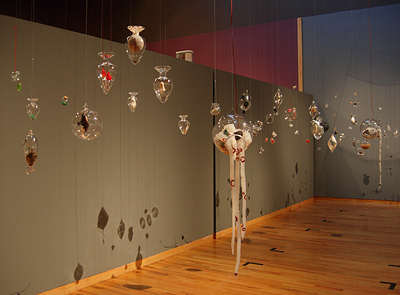
Michael: Sounds like for the Museum of Modern Art it was that you were in the right place at the right time with the school you were in.
YaYa: Yeah, and I try to grab whatever opportunity I can. Some things sound really big, and a lot of times they are really conventional, but I never know, so I say as many yeses as I can. A lot of my shows, I don't go out and find galleries. The opportunities came to me. And I don't say no. Even if I have to postpone the exhibition date, I will still say yes and start a conversation right there.
Peggy: Was the Fort Wayne Museum of Art show something you submitted, or did they come to you? Where did they find you?
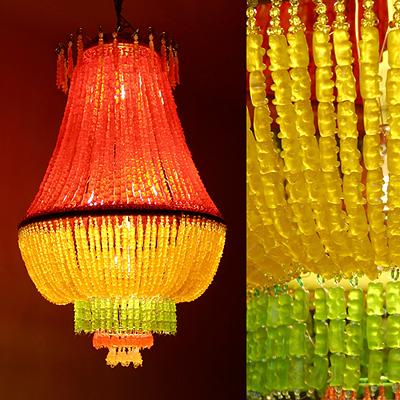
YaYa: The curator saw my gummy bear chandelier somewhere. I made the first one in '05, and submitted the image to Make magazine's blog. They feature hand made robots and other crazy stuff. I thought, "My stuff can work." So I just sent it to them and overnight it became a big sensation.
I got so many interviews, and bloggers reposted the images, and somehow the curator saw it and asked if I would like to have a show. And I said, "Of course!" However, I didn't end up showing my gummy bear work there. I was pretty burned out on that by then. It came early in my career, and I didn't really know what to do with that kind of attention. I didn't want people to think I only make gummy bear stuff. So I intentionally held off for a year not making more of that work.
Peggy: And the Montalvo Artist Residency. have you already done one and you are going back?
YaYa: No, I got an award this year and I'm going next year.
Michael: So it hasn't happened yet.
Peggy: How does that work? do you submit, or do you get nominated, or...?
YaYa: That's a nomination only. One of my good friends won an award and went there, and she nominated me, and so I applied. OK, I hate to say this but I want to say that I'm good enough, but it turned out that I know someone who works in that residency program. Just to clarify, this person was not on the jury panel who selected me. In the past, I had applied through the Visions from the New California Awards by Alliance of Artists Communities, which selected a few young artists to go, and I didn't make it. I made it to the final round but I didn't win the award. So this is another way to get in.
Peggy: But that's fabulous. It's a great spot and a great program.
YaYa: I think so. I've never been there. I'll invite you guys over when I go. You will be my guests in the studio.
Peggy: We have family near by so we will come see you there.
And then the magazines—Sculpture Magazine, Fiber Arts, ArtScene—Oh! Artillery. I didn't notice that one.
YaYa: Yeah, Artillery has some freelance writers. It's quite local. A lot of their writers are local, living in LA. But I feel like I have to say something about it. A lot of writers turn into artists nowadays. Who's going to write about us? They start out writing about art and then they say, "Oh god, being an artist is nice!" So everybody's sculpting or painting, and not as much writing.
Michael: Well, we've sort of gone the other direction.
YaYa: Well, thank you.
Peggy: We were just talking about that.
Michael: Since we've been working on Outside the Lines I've gotten very immersed in it. I haven't been as active making art.
YaYa: But see, everybody seems to be doing some part of it. Making some contribution.
Peggy: And now there's a another show. You should submit. January 28th.
Michael: Well this is a whole different process. I'll tell you about it. You're welcome to submit if you want to. It would be a kind of a whirlwind day for you in San Luis Obispo. We're doing the Phantom Project. I think I spoke to you about this when you were up for the California Slam show. The pop up galleries where you move into some...
YaYa: Storefront?
Michael: Yeah. We've got a vacant storefront. It's a block from the museum, on the main street. All the doors have opened, we've got the keys to the place, we've got the insurance worked out, and we've got the call for entries out. I'll have to send it to you.
YaYa: So are you guys affiliated with this Phantom Project?
Michael: It was my idea to do it. I'm sort of the ring leader of the whole thing.
YaYa: There are a lot of empty store fronts these days. That's what I hear everywhere.
Michael: It's kind of an interesting time. One of the things that struck us about the last interview [Amy McKay, January 2012] was that this depressed economy actually spurred her to do creative things.
YaYa: Kind of lead her to do what's really true inside.
Michael: That's right.
Peggy: You figure out your priorities.
Michael: I think a lot of people are having those kinds of epiphanies now.
YaYa: I have a friend who started making art since the seventies feminist movement, and a few years ago she told me, "I'm not making a buck with this work anyway. Since I'm not making money, I might as well just do whatever I want."
Michael: Speaking of that, you have a social conscience aspect to a lot of the work that you do. Do You want to say anything about that?
YaYa: I am a pretty activist kind of person, especially when it comes to the organic food movement. I always like political stuff but it's really hard to make my art that way. Somehow it comes out very cartoony or naive and childlike, so it just doesn't go over. So I try to do whatever I can to send a message. Most of my reading is the environmental magazines and all that science stuff and it's got to come out somewhere.
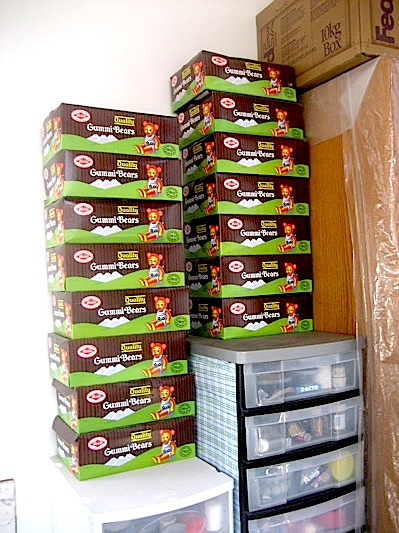
Michael: Well, I think it shows through in some of the things you do. Even with the gummy bear thing it comes out.
YaYa: I'm glad! I don't really want to push it out onto people, like I'm going shove it down your throat. Some people think it's just celebrating gummy bears, which is totally the opposite of what I'm trying to say, but hey, that's fine. And most of the galleries where I show that work don't really want to touch that topic. I had this conversation with my sister. She said, "You know, everybody that writes about that piece, they're not even getting to the point." I say, it's the art world. what can I say? I make it and people need to market it in different ways. It's frustrating, but it's what it is.
Peggy: Not to be crass, but do the gummy bear pieces sell?
YaYa: The first one I sold. A gallery in Florida bought it. She actually wanted me to make more gummy bear work. But like I was telling you, I was burned out and I had to be careful with this career move. Plus, gummy bear works are just too time consuming.
Michael: You actually have a number of the gummy bear pieces.
YaYa: Yeah, but a few of them actually, like the bear rug, I didn't know at the time that the green color is not stable, so it turned yellow. So I just had to toss it out.
Peggy: That makes you wonder what's in it!
YaYa: Yeah! But the thing is that if a collector buys it, I don't even know how long it would last. And it's really hard to sell those things, because it's weird, and people don't know what's gonna happen to them. And they worry about bugs a lot. And I don't know why, because you see, there's nothing happening to them.
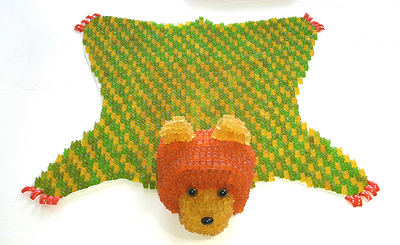
Peggy: It's not going anywhere.
YaYa: Nooo!
Michael: That touches on something else. You do a lot of installation shows, and you've done the gummy bears, which are not stable, and they're hard to sell. There's a balance between doing creative work for the sake of creative expression, and finding a way to find a home for your work and to be able to sell things.
YaYa: [Laughter] Yeah, it's sad! I don't know how that works still.
Michael: But it seems like you're doing both.
YaYa: You think so?
Peggy: Are you?
Michael: Well, I don't know. A lot of the work that I've seen is tangible pieces that seem like they would last. So if someone bought it in a gallery, they'd know that they had something, but on the other hand, an installation isn't always intended to be sold. Maybe there's a grant that pays for it. Is that how that works for you?
YaYa: Yeah, grants. But I haven't gotten a grant for a year or two. It seems to be easier when you are still an emerging artist. Plus, there's not a lot of resources in LA. Santa Monica's Durfee Foundation gave me two grants which I am really grateful for, but getting the next one could be difficult. I'm not selling as much as I'd like to. A lot of my friends find this surprising but I actually toss my work out every three years if it isn't sold. If I make something and it's taking up space, it goes in the trash.
This year I told my husband, "I'm not piling the yard full of shit. It's just clutter. I don't like clutter." I did a temporary public art thing with a lot of whales sculptures, and now they are piling up there like eye sores. I'm just going to give them to the neighborhood kids. If they don't cost a lot, and it's mostly my labor, and I feel like if I keep them, they'll drag me to the past, I'd rather get rid of them. I can always make more if I need to. I think my works that have sold are usually weird pieces. I made a piece with burnt toast. And those are more experimental, so I sell them really cheap. Somehow the collectors seem to like the really weird stuff and they grab it as soon as they see it.
Peggy: Have those been shown in the galleries, or in the museums?
YaYa: Galleries.
Peggy: Do you have a regular gallery?
YaYa: I had a solo show in September. I'm hoping this will become my regular gallery.
Peggy: Was that the one at Pacific Design Center?
YaYa: Yes, den contemporary art.
I had a gallery in '06 and that one closed in '07. I've had a few galleries and really really good relationships, and then everybody started closing down because of the economy. I think that's what is happening to a lot of artists right now.
Michael: That's a common story.
YaYa: You feel like you belong somewhere, and then, boom! They're gone.
And also, I think there is a changing trend for galleries. They used to invest in an artist, and they see you grow, and they foster your career, and they stay with you, but I don't see that much any more.
Michael: So the old way was more like an agent relationship, where the gallery acted as your representative.
YaYa: Yeah, I think it used to be that way.
Michael: But not so much now?
YaYa: Now it seems like there are so many young artists coming out of art school every year, a gallery doesn't have to stay with an artist, not even for five years. If this is fresh, it's hot, it sells, you get the artist on board for a year or two, or for a few shows. Well, great! see you later. Because there's a fresh new batch coming out every year.
Peggy: And that's what's hot, and new...
YaYa: I know a lot of galleries go to MFA open studios to pick their artists now. So I think that's how it's changing. The young and the hot. [Laughter] That sounds very negative!
Michael: No, that's a good observation.
YaYa: I can understand. If I run a business, and I can't guarantee this artist will last, and people's taste change. Galleries have to survive, and they have to have a strategy to always show something new.
Peggy: How did you start showing? Was it through the Cal Arts MFA program? Did it open doors?
YaYa: I was in the animation department, so we don't operate like fine art departments. In my last year, I had a teacher from Germany. She's a sculptor, and she teaches miniature set design for clay animation. She was the first one and for the first time in my life anybody told me that I actually had the talent to be an artist. She said, "You've got a really nice sense of space." I thought to myself, "Really? I have what it takes!" Even after I graduated, she encouraged me to make art, not just films. I started taking community college classes to learn how to sculpt, and I just started...
Peggy: We saw that one animation...
Michael: The Silhouette?
YaYa: Yeah.
Peggy: Was that clay, the street scene?
YaYa: That was built from cardboard and I took photos of it.
Peggy: It almost looked like it had a clay surface on the building fronts.
YaYa: It's probably the paint, maybe.
Michael: That was a nice piece. I enjoyed it.
YaYa: Really? Thank you!
Peggy: It seemed almost three dimensional.
YaYa: Yeah, because my puppets are cut out, I couldn't shoot it like a real scene, so what we do is we have 3 layers of glass, and the puppets are on top, and the background people are in the middle, and the bottom is the background photo. So when the camera shoots it you see shadows of the cut out, but it's not real 3D shadow. But it kind of makes it look three dimensional.
Michael: I liked that piece, because it really was a commentary on the whole fashion industry, and the spinning cycle of craziness that women are put through for the sake of some image of beauty.
YaYa: The mimicking and the losing themselves.
Michael: Yeah.
YaYa: Thank you!
Michael: And that's a good example of what I was talking about, about the social commentary aspect of your work. So it's there.
YaYa: I'm glad. I'm ok with it. For people who can see it, they see it.
Michael: Who are your influences? Who has inspired you, as creative people? Anybody we might know?
YaYa: Louise Bourgeois. Kiki Smith, she's one of my favorites. I'll show you the book. When I first started I did embroidery for my animation, so it's mostly fiber artists.
Mostly artists who work with fabric and all kinds of material. I don't enjoy artists who stick with one medium too much.
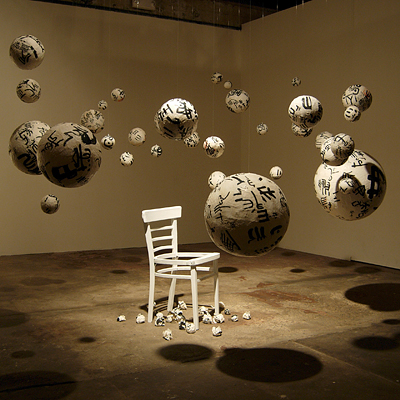
Peggy: I love that installation with the chair and the balls.
YaYa: I still have a whole shelf full of the balls.
Peggy: Wait. Was that more than three years ago?
YaYa: Would you like to have a ball? [YaYa took a ball down from a shelf to show us. Later that week she joined us for our annual Japanese New Years's party, and brought us several of the balls from that installation.]
Peggy: Those are beautiful.
YaYa: Those are my mom's calligraphy studies. She threw them away, so I saved them.
Michael: So then you applied them to the balls.
YaYa: I was going to make a whole series of old vintage clothing out of them. I should start working on that.
Peggy: They're fabulous.
YaYa: And they're nice paper. I couldn't just throw them away.
Michael: What do you do when you get stuck? Do you ever get stuck creatively?
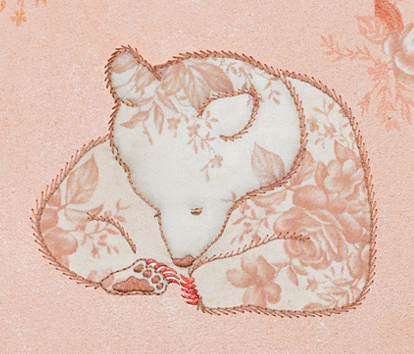
YaYa: Oh yes. Creatively, when I get stuck, I will pull out all my clothing that needs to be altered and I'll alter my clothes.
If I have not been working for a long time, it's hard to get back in the studio, so I will just start sewing.
Michael: That's very interesting. I never would have thought of that, but it's still that making and doing process that's involved in studio work.
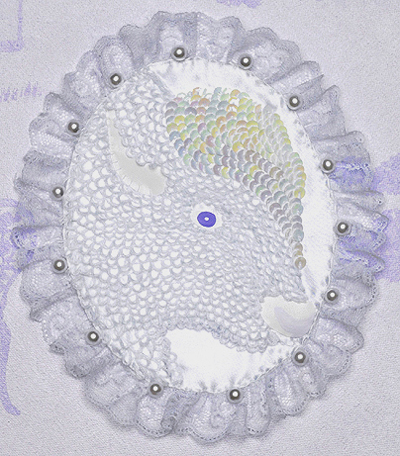
YaYa: Yeah, and I think that's my favorite thing. Sewing, stitching, but somehow it just almost never shows up in my work. But I did some embroidery on some paintings
when I first started, but the response was not that great, and it was too time consuming. I think it's still a fine line between crafts and art, and how the galleries or even regular people take it. Especially for my stuff that came out kind of childlike or naive. They might find it a very childish thing. It's not like I embroidered some political stuff, then they would have a totally different take on it. So a lot of choices to make there.
Peggy: But that's what's neat. You do all kinds of different media and material. What were the whales made out of?
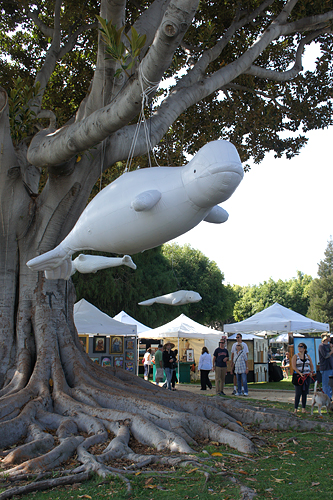
YaYa: Chicken wire, and I put fabric over it. But the main whale was an vinyl inflatable made according to my maquette.
Michael: How about your work style. Do you work in spurts, or do you come in the studio and work every day and do your time on regular hours?
YaYa: Yeah, I try to come in during the day, but of course it's mostly cleaning the studio. I spend more time cleaning and organizing than making art. But then when a show comes up, it's always...
Michael: Ah, deadlines!
YaYa: Yeah, for me it's deadlines. And I create my own deadlines a lot of times, because I'm always on the next opportunity when this one is closing, and then somehow they all come at the same time. My husband says, "you've got to stop taking on so many things." But when a conversation is starting, you never know how long before it will lead to a result, right? I can't just not talk to people. When the email comes, I've got to start thinking about what am I going to do for the next project. I've got to keep busy. I've learned that if the hands are not busy the brain goes crazy. It can really sabotage you, right?
Michael: Yeah, that is true.
YaYa: The brain has its own very strong power.
Peggy: Oh, what are these down here?
YaYa: Those are my barnacles.
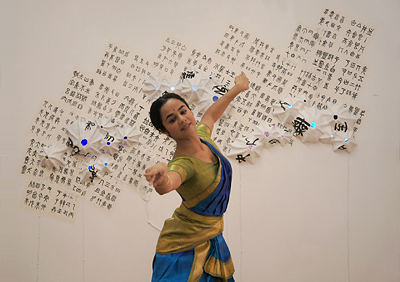
Peggy: I was thinking that's what they were. Is it fabric?
YaYa: I'll show you a picture of it. [YaYa and Peggy begin paging through a book of her work. The next several images are from that book.] It's an installation at a gallery in New York. The gallery wanted me to do a performance piece with installation, so I created these sculptures, then worked with a choreographer/dancer on the performance. The barnacles are made with clay, I stretched plaster bandages over them and applied more plaster over to create thick shells. They are hollow inside. I inserted LED lights, and miniature sculptural scenes like ocean scenery, dried fish, sea salt and seaweed. The whole thing is about my memory of Taiwan's sea port villages. I found an Indian Dancer and she did a piece about swimming for the installation.
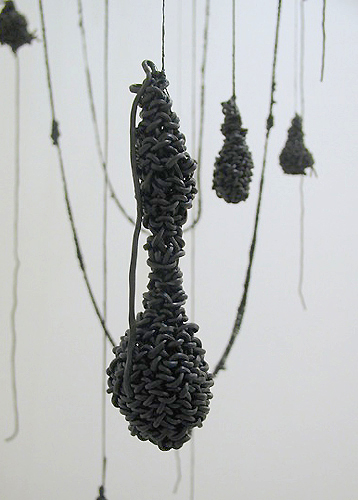
Peggy: Wow. It's crocheted licorice lace, rubber coated fibers, and painted chicken wire. That's amazing.
YaYa: See, like that, I had to toss, because they don't last very long. They dried out and crumbled.
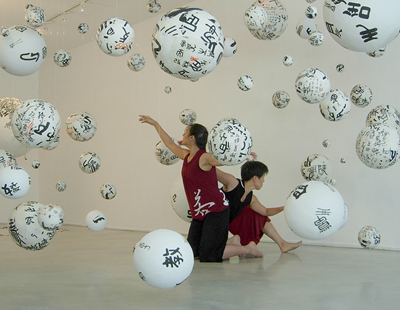
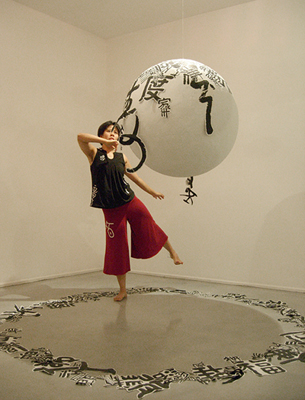 And these pictures are from the first time I worked with choreographers to put dance to the installation that I did.
And these pictures are from the first time I worked with choreographers to put dance to the installation that I did.
Michael: How about that delicate balance between your family time and your art? Or is it delicate?
YaYa: That's not too delicate for me, because my husband is very giving. He used to be a musician, and he wrote music, so he knows what an artist's life is like. When he comes home and I'm in the middle of something, and I'm not very responsive, he would retreat. And he knows that if I'm working, there will be no dinner, or dinner won't happen until 9pm.
Peggy: Where does he work?
YaYa: He works in a film lab that processes movies. It's very close, in Burbank. That's why we moved here, so it would be easier for him.
I always keep an eye on not being too self centered. Marriage is about two people, not my career, after all.
Michael: It sounds like he's very supportive.
YaYa: Yeah, he is. Every time I install a show, he's there to help.
Michael: He was there when you picked up from the Slam show.
YaYa: Yeah, he's my engineer, too. That I'm very grateful for. And if I lived in Taiwan it would be a different story, so that's why I don't think I would go back. He understands, but I don't think every family member can understand that time alone, and how much time you really need to be alone.
Michael: How does your family feel about your art career? Are they supportive?
YaYa: My mom is very supportive, but she still thinks it's better if I get a full time job, like teaching or something. My sisters are really supportive, but I don't know how they actually feel about it. Because my other sister, although she runs a theater, she is also a tenured professor. She knew that she had to make a living. And I think my dad just totally doesn't understand. He doesn't know how to introduce me to people, because like with my sisters they have a job but with me he just doesn't know what to say.
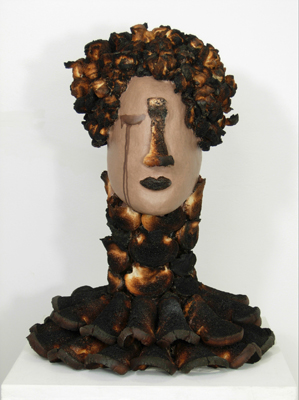
Peggy: This is the burnt toast. I hadn't seen these. I can see why people will buy these.
YaYa: We'll see how they do. They should be pretty strong, I think, because I stuck them well in the paperclay, and it's a special clay with cellulose fiber. When you bind anything to it that has a lot of vegetable fiber, like paper or straw, or branches...
Michael: Or toast.
YaYa: Yeah, or toast. What happens is the fiber is entwined, so they really bind very strong. As long as it doesn't get moldy.
Michael: Arizona, or someplace really dry.
YaYa: Yeah, LA is good.
Peggy: How did you burn the toast? They are all shapes.
YaYa: I pinned each slice with a toothpick and I put them in the toaster oven. And the toaster oven caught on fire a few times. My husband said, "you've gotta stop it. This is crazy."
Michael: What's next for you?
YaYa: I've been thinking about public art sculpture for a long time. I've been learning welding, by the way.
Peggy: Excellent!
YaYa: I met this teacher, he's very young, and he rents a big studio where you can rent studio hours, he will be there to watch and help a little. Make sure you don't burn down the place, or kill yourself.
Peggy: Where's that?
YaYa: In Eagle Rock. I heard that a few big artists have studios down there, too. They all have full time studio assistants who do a lot of work for them...
Peggy: Doing the fabricating for them.
YaYa: Yeah. So public art is something I want to try. Maybe I'll build a few pieces for a portfolio of that sort of work. Also, as for my next project, there's an organic gummy bear company that wanted me to do a few pieces for their trade show.
Michael: Of course!
YaYa: They actually had talked to me a few years ago, but I was not willing to work for cheap, so we'll see how that goes. I had a concern that my gallery may not be very happy about this gig, but I don't have a part time job like some artists do, so for me, that is a freelance project to get money rolling if it works out.
Peggy: So what does keep you going when it's tough.
YaYa: I'm just gonna be like a cockroach. I'm just gonna stay. I can't get killed, you know.
Peggy: She keeps coming back!
YaYa: She won't die! What's wrong?
It's been tough the past year. But then it's not like I haven't accomplished something. If I stop, I would have failed myself for what I've been working for in the past so many years.
Michael: I've heard it said that more than talent or anything like that, the thing that really distinguishes successful artists from would-be successful artists, is the refusal to ever give up.
YaYa: But then there are those who never give up until they're dead! Right?
Michael: Yes, Like Van Gogh. Well, I've heard it said. I don't know if it's true. But there's something to be said for persistence either way. If you're not persistent, then you certainly won't make it, even if you're very talented.
YaYa: That is definitely the first ingredient. If you are not creating the work, you are not the artist at all.
I guess it depends on how you define being successful, too. I have a friend from Cal Arts, she actually is doing very well. Her paintings are hugely expensive, and she's showing a lot in New York and Europe. Some artists friends and I all agree that she knows the game of business. She chose a strategy that does not make her work look too different over the past several years; she is very careful how and what she paints. She also has a very good relationship with the media, and there are a whole bunch of cheerleaders behind her.
Michael: I think you've really touched on something.
Peggy: Galleries want you to have your certain look.
YaYa: Oh yeah. Persona. Right.
Peggy: They can't sell something different from what is identifiably you.
YaYa: Already known that it's yours. I think that's another thing for me. It's hard to make a gallery feel secured with me. I'm always changing. And I can see how from a business perspective, it's very dangerous. If you sell tacos you don't sell Chinese food.
Michael: I have this fantasy of creating half a dozen different artist personas with different names and different biographies so that I can do all these different things I want to do, and still fulfill their requirement that it all be the same. So different galleries would know different personas.
YaYa: And they don't know that it's all you.
Michael: Right. Sometimes you wear a mustache and dark glasses and a hat.
YaYa: A cowboy hat, a dark coat. That lifestyle is not for everybody. I don't do late night parties like some artists do. I know this painter friend of mine networks really, really hard too.
Peggy: Do you have a network or support group of fellow artists?
YaYa: I have some close friends, and I'm a member of Los Angeles Art Association. But I don't really hang out that much there. I sometimes try not to go out and see shows too much either, because it can be very distracting. It's hard to not be influenced when you see "loud" work. And lot of what's going on in galleries in LA is really commercial stuff. I find that really dangerous. You can go home and say, "Oh look! That kind of painting sells really well. Why don't I make some too."
Peggy: This art association. Where is it based?
YaYa: The office is in West Hollywood, on La Cienega Boulevard.
Peggy: Do they have studio space, or classes, or is it just offices.
YaYa: Offices and a gallery. And what happened is they gave me a lot of opportunities. Like the Beverly Hills Art Show, they wanted me to do a public art thing, so I did the whales installation for them. And a liquor company wanted to pay artists to make art live on Hollywood Boulevard, so I did that for a week. So it's like little gigs here and there lead to exposures; sometimes I am introduced to curators through them that lead to exhibitions. And they have very good collectors too.
Peggy: So where was this live art thing? Outside, or inside?
YaYa: An empty storefront. Right across from the Kodak Theatre on the Hollywood Walk of Fame. There's an empty space. And all the artwork made will be auctioned off to benefit the art association.
Michael: Is there anything you would change about your art career so far, if you could do it over? It doesn't have to be, but it would be interesting to know.
YaYa: I wonder. If I had known, would I have made similar looking sculptures, just to see if that's something that would land on something...profit making. [Laughter]
But that's just not my nature, to work on the same thing. I get so bored.
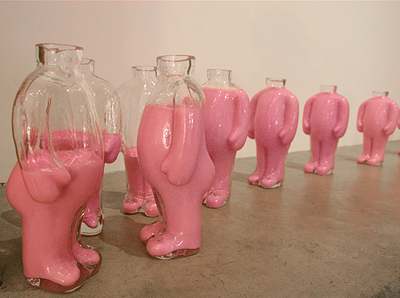
Peggy: I love the way it's all this different stuff. Where does this concept come from? The Pepto Bismol one?
YaYa: That's another food safety concept. All the artificial colorings make kids very hyper, and then the idea to calm your stomach with that kind of stuff just does not make sense. There is alcohol and saccharin in Pepto Bismol, which is really, really bad stuff.
Michael: There's one question we like to ask everybody, and that is, "What advice would you give to a young person who is just starting out and wants to be an artist?"
YaYa: I say find your own voice. Be original. And be like the cockroach. [Laughter]
Michael: That's an excellent answer.
YaYa: You guys interview a lot of artists. Probably everybody has the same concepts for that answer.
Michael: You know, it's interesting that the answers we get to that question, they tend to have a thread of similarity, but everybody has a little different perspective.
Peggy: And everyone's path has been really different. I think that's one of the things we're trying to let people know. There's no one right way to do any of this. You've just got to do it.
YaYa: For a lot of years I have been reading a lot of artist career training and business savvy materials. And being fed all of this about networking and follow-up and all that marketing stuff. And at a point, you look at what's happening all around you. Sometimes if it's not the right personality it doesn't even work. I have this high school friend in Taiwan. She never went to art school. She didn't know that when you paint on canvas you have to prime it first. She usually painted on bare wood or pieces of cardboard. And there's a big artist in Japan, Takashi Murakami.
Peggy: The print guy?
YaYa: He sells a lot of cartoony flower things.
Peggy: Ok, yeah.
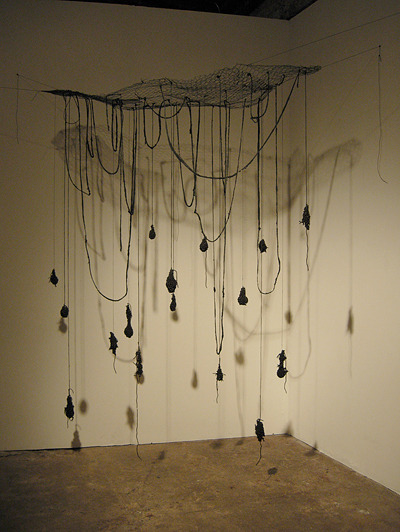
YaYa: Some of his paintings are very serious though. Anyway, He started an art fair called GEISAI, where artists can rent a booth to show their work. He also started a gallery in Taiwan, with all the top of the pyramid connections. Japanese artist Yoshitomo Nara was invited to jury the Geisai fair and saw my friend's work at the festival. He was very attracted to the little clay figurines and drawings my friend made and bought almost all of it that day. Ever since that day, my friend was signed on by Murakami's galleries, and she has had two solo shows in the past two years, both were sold out shows. The biggest art critics in Taiwan bought her works, Gagosian Gallery sent curators to see the show, and Nara got hold of the price list before the second show opens and bought many pieces.
Last time I was there I saw her works and they're lovely. But they're not anything like the American market will go crazy for. They're like cartoony dreamy girl in the forest setting. Her drawings and paintings are nice, but not like the paintings you'd see in the western art world. In this side of the world, a good painting has to represent the prestige of either art history, revolutionary techniques or social commentary. My friend is someone who never touched the art world yet landed in a golden opportunity. She is concerned about not having a high enough selling price, and I told her, "You have no idea how lucky you are!" This is a person who doesn't make any business effort. She's very shy, she seldom talks to anybody.
Michael: So she's not doing all of that marketing networking stuff.
YaYa: No web site. No cell phone. You can hardly find her when you call her.
Peggy: She was in the right place at the right time.
YaYa: Sometimes I think, Wow! I don't even know what's real and what's not real anymore.
Michael: And there's the biggest challenge and mystery in all of this. It's all so subjective. I mean, who knows? Who knows what's going to work when, and where?
YaYa: And with what?
Michael: Who, what, when, and where?
YaYa: Yeah, what I've learned is to not have too much expectation, and just go with the flow and enjoy it. I feel like in 20 years, if I don't become a better artist, I might become a more enlightened Buddhist nun. [Laughter]
I might learn more about life than art.
Michael: Or at least you'll be a really good cockroach.
YaYa: Yeah! A cockroach who doesn't even care what people say or think about me.
Michael: That's kind of Zen.
YaYa: The only thing that keeps me sane when I'm working on a big show, and I have all this fear and doubt and expectation, I have to listen to a lot of self help lectures while I work so I don't explode.
Peggy: So what do you listen to?
YaYa: Ekhart Tolle . .
Michael: Eckhart Tolle came up last month too. Amy had his book in her studio.
YaYa: I have other teachers. But with him you can listen for many times, and every time you hear something new. And he says it so simple but in every occasion it works.
Michael: We'll have to write an article about Ekhart Tolle.
YaYa: How he's keeping artists sane. But then I sometimes think, "Oh you're just saying all this so I will be content with what I have and I won't dream bigger. [laughter]
Michael: That is an interesting take on it. For me, and I'm sure you would agree with this, his message is that all the big doom and gloom crisis that you anticipate doesn't even exist. You look in this moment, and almost every moment of your life is better than the things you worry about that could happen.
YaYa: Yes. But isn't it funny that we keep worrying anyway. The only reason it makes me feel better is that I think all the famous artists are suffering like I do.
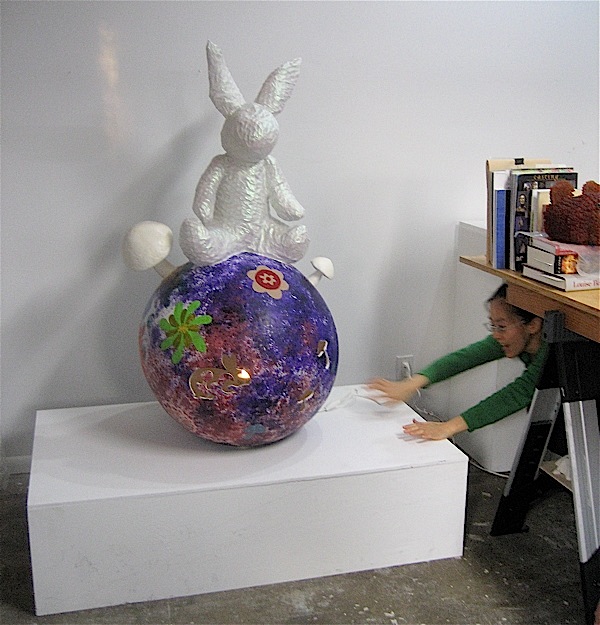
After the recording stopped, YaYa showed us the Moon Rabbit Lantern. She had to crawl under a table to turn on the lights inside. We got this great action shot that seemed to capture the essence of YaYa perfectly!
| 
 YaYa Chou is a sculptor, film maker and food activist in Los Angeles. We first met her when she entered
YaYa Chou is a sculptor, film maker and food activist in Los Angeles. We first met her when she entered 











 And these pictures are from the first time I worked with choreographers to put dance to the installation that I did.
And these pictures are from the first time I worked with choreographers to put dance to the installation that I did.





